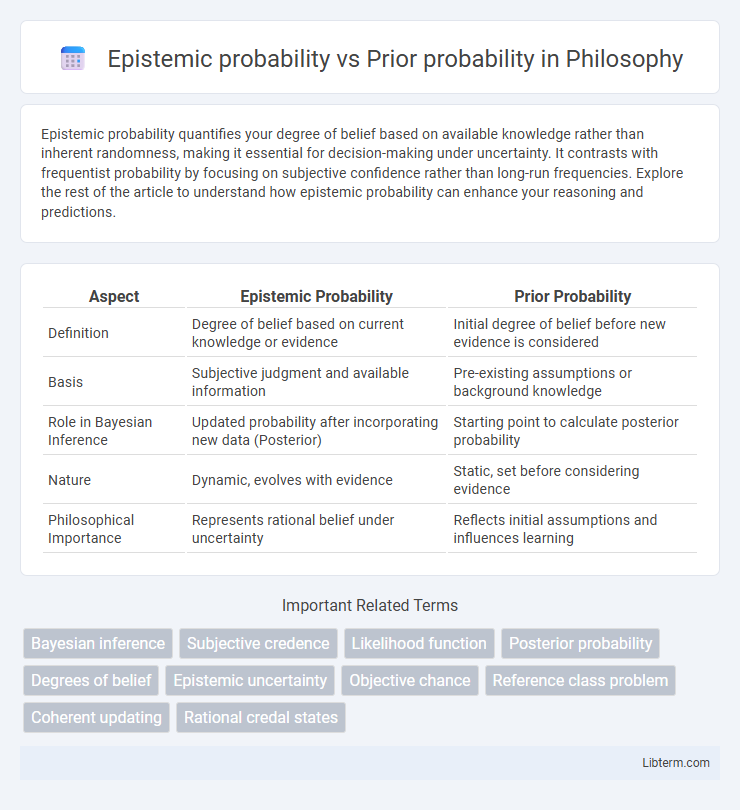Epistemic probability quantifies your degree of belief based on available knowledge rather than inherent randomness, making it essential for decision-making under uncertainty. It contrasts with frequentist probability by focusing on subjective confidence rather than long-run frequencies. Explore the rest of the article to understand how epistemic probability can enhance your reasoning and predictions.
Table of Comparison
| Aspect | Epistemic Probability | Prior Probability |
|---|---|---|
| Definition | Degree of belief based on current knowledge or evidence | Initial degree of belief before new evidence is considered |
| Basis | Subjective judgment and available information | Pre-existing assumptions or background knowledge |
| Role in Bayesian Inference | Updated probability after incorporating new data (Posterior) | Starting point to calculate posterior probability |
| Nature | Dynamic, evolves with evidence | Static, set before considering evidence |
| Philosophical Importance | Represents rational belief under uncertainty | Reflects initial assumptions and influences learning |
Understanding Epistemic Probability
Epistemic probability represents the degree of belief or confidence in the truth of a proposition given incomplete knowledge, reflecting subjective uncertainty and information updates. Unlike prior probability, which serves as an initial assignment before evidence, epistemic probability evolves with new data, capturing the dynamic process of learning and reasoning. This interpretative framework is crucial for Bayesian inference, where epistemic probabilities drive the adjustment of beliefs based on observed evidence.
Defining Prior Probability
Prior probability represents the initial estimation of an event's likelihood based on existing knowledge before new evidence is considered. It serves as a foundational input in Bayesian inference, quantifying beliefs grounded on historical data or subjective judgment. Unlike epistemic probability, which reflects uncertainty due to limited information, prior probability formalizes known assumptions to update predictions systematically.
Fundamental Differences Between Epistemic and Prior Probability
Epistemic probability quantifies an observer's degree of belief or knowledge about an event, reflecting subjective uncertainty based on available evidence, while prior probability represents the initial likelihood assigned to an event before new data is observed, often derived from historical or theoretical considerations. The fundamental difference lies in epistemic probability updating as evidence accumulates, inherently dynamic and belief-driven, whereas prior probability serves as a static baseline in Bayesian inference, anchoring posterior probability calculations. Understanding this distinction is crucial for accurate probabilistic modeling and decision-making under uncertainty.
The Role of Belief and Knowledge in Probability Assessment
Epistemic probability reflects the degree of belief or knowledge an individual holds regarding the likelihood of an event, incorporating subjective uncertainty and partial information. Prior probability represents the initial assessment of an event's likelihood before new evidence is considered, typically based on historical data or established theory. The interplay between epistemic and prior probabilities is crucial in Bayesian inference, where updated beliefs are formed by integrating prior knowledge with current evidence.
Bayesian Perspective: Connecting Prior and Epistemic Probabilities
In the Bayesian perspective, prior probability represents the initial belief before new evidence, while epistemic probability quantifies uncertainty based on knowledge or information about the event. Prior probabilities serve as a foundational input updated via Bayes' theorem to reflect epistemic probabilities after data is observed. This connection allows Bayesian inference to systematically revise beliefs, combining subjective beliefs and empirical evidence into coherent posterior probabilities.
Sources and Calculation of Prior Probabilities
Epistemic probability represents the degree of belief based on knowledge or evidence, whereas prior probability is a key component of Bayesian inference representing initial beliefs before new data is considered. Sources of prior probabilities often include historical data, expert judgment, or frequency distributions from relevant past events. Calculation of prior probabilities typically involves statistical analysis of existing datasets or elicitation techniques that quantify subjective beliefs to form a foundation for updating with observed evidence.
Epistemic Probability in Decision Making
Epistemic probability quantifies uncertainty based on knowledge or evidence, reflecting an agent's degree of belief about the truth of a proposition in decision-making contexts. It differs from prior probability, which represents an initial assumption before new data is considered. By incorporating updated information and subjective knowledge, epistemic probability enables more informed and adaptive decisions under uncertainty.
Common Misconceptions Between Epistemic and Prior Probability
Epistemic probability reflects a degree of belief based on knowledge or evidence, while prior probability represents initial assumptions before new data is considered. A common misconception is that prior probability is fixed and objective, whereas it is often subjective and can vary between observers. Confusing these probabilities can lead to improper Bayesian updates and misinterpretation of uncertainty in probabilistic models.
Applications in Statistical Inference and Machine Learning
Epistemic probability quantifies uncertainty due to limited knowledge, playing a crucial role in Bayesian inference where it updates prior probability based on observed data. Prior probability represents initial beliefs before evidence, serving as the foundation for Bayesian models in machine learning algorithms such as Bayesian networks and Gaussian processes. Applying epistemic and prior probabilities improves model robustness by explicitly accounting for uncertainty and guiding data-driven decision-making in statistical inference and predictive analytics.
Choosing the Right Probability Concept for Your Analysis
Epistemic probability measures uncertainty based on incomplete knowledge, making it ideal for contexts involving belief revision and updating models with new information. Prior probability represents initial assumptions before evidence is considered, serving as a foundational element in Bayesian analysis for setting baseline expectations. Choosing between epistemic and prior probability depends on whether your analysis emphasizes knowledge-driven uncertainty or baseline hypothesis assessment in probabilistic modeling.
Epistemic probability Infographic

 libterm.com
libterm.com